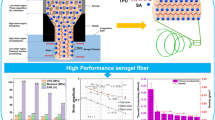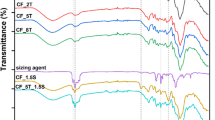Abstract
Carboxymethyl chitosan was pulverized to nanopowder (NCMC) with a diameter of 483 nm through ball-milling. 400 mg NCMC was successfully electrospun to nanofibers with the assistant of 4 g poly (lactic acid) (PLA) to prepare NCMC/PLA nanofibrous composite mats. Scanning electron microscope images revealed that there were no NCMC particles in the NCMC/PLA mats, indicating NCMC had been stretched to nanofibers. NCMC/PLA mats with different morphology could be prepared through adjusting the electrospinning voltage at 12–30 kV and the distance at 10–22 cm. The presence of NCMC increased the spinnability of PLA according to the electrospinning parameters. X-ray photoelectron spectroscopy and Fourier transform infrared spectroscopy verified the existence of NCMC in the mats. Crosslinking with glutaraldehyde increased the stability of NCMC/PLA in water. Crosslinked NCMC/PLA mats expressed good blood compatibility according to the results of blood clotting time and platelet adhesion experiment. The methodology of preparation nanofibers from polymer nanopowders through electrospinning could be used to prepare more composite nanofibers while adopting different raw materials.








Similar content being viewed by others
References
Teo AJT, Mishra A, Park I, Kim YJ, Park WT, Yoon YJ (2016) Polymeric biomaterials for medical implants and devices. ACS Biomater Sci Eng 2(4):454–472
Kohane DS, Langer R (2010) Biocompatibility and drug delivery systems. Chem Sci 1(4):441–446
Weber N, Wendel HP, Ziemer G (2002) Hemocompatibility of heparin-coated surfaces and the role of selective plasma protein adsorption. Biomaterials 2(3):429–439
Ercolani E, Gaudio C, Bianco A (2015) Vascular tissue engineering of small-diameter blood vessels: reviewing the electrospinning approach. J Tissue Eng Regen Med 9:861–888
Li Q, Dunn E (1992) Applications and properties of chitosan. J Bioact Compat Polym 7:370–397
Weber N, Wendel HP, Ziemer G (2002) Hemocompatibility of heparin-coated surfaces and the role of selective plasma protein adsorption. Biomaterials 23:429–439
Balan V, Verestiuc L (2014) Strategies to improve chitosan hemocompatibility: a review. Eur Polym 53:171–188
Yang Y, Zhou Y, Chuo H, Wang SY, Yu JG (2007) Blood compatibility and mechanical properties of oxidized-chitosan films. J Appl Polym Sci 106:372–377
Sharon S, Katanchalee MN (2005) Chitosan based surfactant polymers designed to improve blood compatibility on biomaterials. Colloids Surf B: Biointerfaces 42:147–155
Riccardo AAM, Fabio T, Monica E (1984) Sulfated N-(carboxymethyl) chitosans: novel blood anticoagulants. Carbohydr Res 126:225–231
Dawei F, Baoqin H, Wen D, Zhao Y, Lv Y, Liu WS (2011) Effects of carboxymethyl chitosan on the blood system of rats. Biochem Biophys Res Commun 408:110–114
Zhu AP, Chen T (2006) Blood compatibility of surface-engineered poly(ethylene terephthalate) via o-arboxymethylchitosan. Colloids Surf B: Biointerfaces 50(2):120–125
Braghirolli D, Steffens D, Pranke P (2014) Electrospinning for regenerative medicine: a review of the main topics. Drug Discov Today 1(9):743–753
Chen H, Song W, Zhou F, Wu ZK, Huang H, Zhang JH, Lin Q, Yang B (2009) The effect of surface microtopography of poly(dimethylsiloxane) on protein adsorption, platelet and cell adhesion. Colloid Surf B 7(1):275–281
Doshi J, Reneker DH (1995) Electrospinning and applications of electrospun fibers. J Electrost 3(5):151–160
Reneker DH, Chun I (1996) Nanometre diameter fibres of polymer produced by electrospinning. Nanotechnology 7:216–223
Ohkawa K, Cha D, Kim H, Nishida A, Yamamoto H (2004) Electrospinning of chitosan. Macromol Rapid Commun 25:1600–1605
Theron SA, Yarin AL, Zussman E, Kroll E (2005) Multiple jets in electrospinning: experiment and modeling. Polymer 4(6):2889–2899
Ding F, Deng H, Du Y, Shi X, Wang Q (2014) Emerging chitin and chitosan nanofibrous materials for biomedical applications. Nano 6:9477–9493
Kriegel C, Kit K, McClements DJ, Weiss J (2009) Electrospinning of chitosan–poly (ethylene oxide) blend nanofibers in the presence of micellar surfactant solutions. Polymer 50:189–200
Du J, Hsieh YL (2008) Nanofibrous membranes from aqueous electrospinning of carboxymethyl chitosan. Nanotechnology19(12):125707
Du F, Wang H, Zhao W, Li D, Kong D, Yang J, Zhang Y (2012) Gradient nanofibrous chitosan/poly −3 caprolactone scaffolds as extracellular microenvironments for vascular tissue engineering. Biomaterials 33:762–770
Min BM, Lee SW, Lim JN, You Y, Lee TS, Kang PH, Park WH (2004) Chitin and chitosan nanofibers: electrospinning of chitin and deacetylation of chitin nanofibers. Polymer 45:7137–7142
Robert P, Mauduit J, Frank RM, Vert M (1993) Biocompatibility and resorbability of a poly(lactic acid) membrane for periodontal guided tissue regeneration. Biomaterials 14:353–358
Tsuji H (2005) Poly(lactide) stereocomplexes: formation, structure, properties, degradation, and applications. Macromol Biosci 5:569–597
Michel V (2015) After soft tissues, bone, drug delivery and packaging, PLA aims at blood. Eur Polym J 68:516–552
Zhao XW, Lin Y, Phil C, Fin CR, Michasel M (2013) Structure and blood compatibility of highly oriented poly(lactic acid)/thermoplastic polyurethane blends produced by solid hot stretching. Polym Adv Technol 249:853–860
Gao AL, Liu F, Xue LX (2014) Preparation and evaluation of heparin-immobilized poly (lactic acid) (PLA) membrane for hemodialysis. J Membr Sci 452:390–399
Li ZQ, Zhao XW, Ye L, Coates P, Caton-Rose F (2015) Fibrillation of chain branched poly (lactic acid) with improved blood compatibility and bionic structure. Chem Eng J 279:767–776
Chen Y, Lin J, Wan YQ, Fei YN, Wang HB, Gao WD (2012) Preparation and blood compatibility of electrospun PLA/curcumin composite membranes. Polymer 13:1254–1258
Reno F, Paul G, Rizzi M, Gatti G, Marchese L (2013) Poly (D,L) lactic acid blending with vitamin e increases polymer hemocompatibility: an hydrophilic effect. J Appl Polym Sci 129(3):1527–1533
Zhang W, Zhang JL, Jiang QX, Xia WS (2012) Physicochemical and structural characteristics of chitosan nanopowders prepared by ultrafine milling. Carbohydr Polym 87:309–313
Zheng BZ, Liu GY, Yao AW, Xiao YL, Du J, Guo Y, Xiao D, Hu Q, Choi (2014) Sensors & Actuators B Chem 195(5): 431–438
Zhang W, Zhang JL, Xia WS (2014) Effect of ball-milling treatment on physicochemical and structural properties of chitosan. Int J Food Prop 17:26–37
Hohman MM, Shin M, Rutledge G, Brenner MP (2001) Electrospinning and electrically forced jets: II. Appl Phys Fluids 13:2221
Reneker DH, Yarin AL, Fong H, Koombhongse S (2000) Bending instability of electrically charged liquid jets of polymer solutions in elec-trospinning. J Appl Phys 87(4):5–31
Theron A, Zussman E, Yarin AL (2004) Experimental investigation of the governing parameters in the electrospinning of polymer solutions. Polymer 45:2017–2030
Rouxhet PG, Genet MJ (2011) XPS analysis of bio-organic systems. Surf Interface Anal 43:1453–1470
Maachou H, Genet MJ, Aliouche D, Christine C (2013) XPS analysis of chitosan–hydroxyapatite biomaterials: from elements to compounds. Surf Interface Anal 45:1088–1097
Yin X, Chen J, Yuan W, Lin Q, Ji L, Liu F (2012) Preparation and antibacterial activity of Schiff bases from O-carboxymethyl chitosan and para-substituted benzaldehydes. Polym Bull 68:1215–1226
Hou X, Wang X, Zhu Q, Bao J, Mao C, Jiang L, Shen J (2010) Preparation of polypropylene superhydrophobic surface and its blood compatibility. Colloids Surf B: Biointerfaces 80:247–250
Maharana T, Pattanaik S, Routaray A, Nath N, Sutar AK (2015) Synthesis and characterization of poly(lactic acid) based graft copolymers. React Funct Polym 93:47–67
Reis EF, Campos FS, Lage AP, Leite RC, Heneine LG, Vasconcelos WL, Lobato ZIP, Mansur HS (2006) Synthesis and characterization of poly (vinyl alcohol) hydrogels and hybrids for rMPB70 protein adsorption. Mater Res 9:185–191
Monteiro OA, Airoldi C (1999) Some studies of crosslinking chitosan-glutaraldehyde interaction in a homogeneous system. Int J Biol Macromol 26:119–128
Karatum O, Steiner SA, Griffin JS, Shi WB, Plata DL (2016) Mechanically durable aerogel composites for oil capture and recovery. ACS Appl Mater Interfaces 81:215–224
Hao PF, Lv C, Yao J, Niu ZH (2014) Wetting property of smooth and textured hydrophobic surfaces under condensation condition. Sci China Phys Mech Astron 57:2127–2132
Nie CH, Ma L, Cheng C, Deng J, Zhao CS (2015) Nanofibrous heparin and heparin-mimicking multilayers as highly effective Endothelialization and Antithrombogenic coatings. Biomacromolecules 16:992–1001
Nie CX, Ma L, Cheng C, Deng J, Zhao CS (2011) Nanofibrous heparin and heparin-mimicking multilayers as highly effective Endothelialization and Antithrombogenic coatings. Biomacromolecules 16:992–1001
Li GC, Yang P, Qin W, Manfred FM, Zhou S, Huang N (2011) The effect of coimmobilizing heparin and fibronectin on titanium on hemocompatibility and endothelialization. Biomaterials 32:4691–4703
Esmaeil SLM, Azadeh G, Ahmad FI (2016) Improving blood compatibility of Polyethersulfone hollow fiber membranes via blending with sulfonated polyether ether ketone, Macromol. Mater Eng 1:1–8
Jansen AJG, Josefsson CE, Rumjantseva V, Liu QYP, Falet H, Bergmeier W, Cifuni SM, Sackstein R, Von Andrian HU, Wagner DD, Hartwig JH, Hoffmeister KM (2012) Desialylation accelerates platelet clearance after refrigeration and initiates GPIbα metalloproteinase-mediated cleavage in mice. Blood 11(95):1263–1273
Xiang T, Yue WW, Wang R, Liang S, Sun SD, Zhao CS (2013) Surface hydrophilic modification of polyethersulfone membranes by surface-initiated ATRP with enhanced blood compatibility. Colloids Surf B: Biointerfaces 110:15–21
Acknowledgements
This work was supported by the National Science Foundation of China (Project No. 21264007, 21466011). The authors appreciate the financial support.
Author information
Authors and Affiliations
Corresponding author
Rights and permissions
About this article
Cite this article
Lv, J., Yin, X., Zeng, Q. et al. Preparation of carboxymethyl chitosan nanofibers through electrospinning the ball-milled nanopowders with poly (lactic acid) and the blood compatibility of the electrospun NCMC/PLA mats. J Polym Res 24, 60 (2017). https://doi.org/10.1007/s10965-017-1224-5
Received:
Accepted:
Published:
DOI: https://doi.org/10.1007/s10965-017-1224-5




